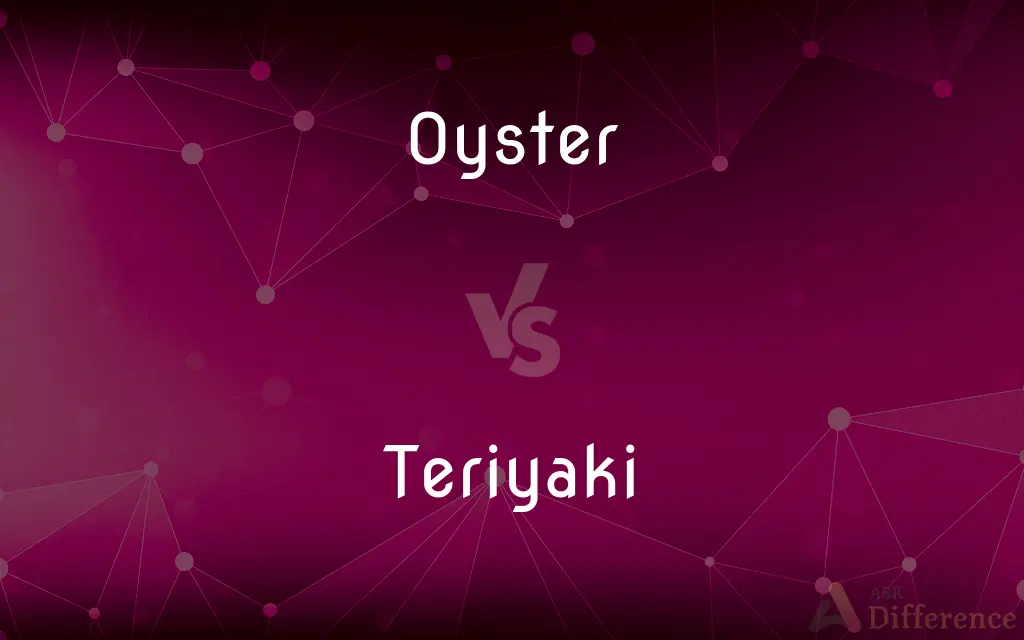Oyster vs. Teriyaki — What's the Difference?
By Urooj Arif & Maham Liaqat — Updated on April 4, 2024
Oysters are a type of shellfish known for their distinctive taste and texture, while teriyaki is a Japanese cooking technique involving soy sauce-based glaze.

Difference Between Oyster and Teriyaki
Table of Contents
ADVERTISEMENT
Key Differences
Oysters, often enjoyed raw or cooked, are valued for their rich, briny flavor and are a source of various nutrients, including zinc and vitamin B12. On the other hand, teriyaki refers to a cooking method where foods are grilled or broiled with a glaze of soy sauce, mirin, and sugar, giving dishes a savory-sweet flavor profile.
Oysters can be found in marine habitats and are cultivated for food and pearls, contributing to their economic value. Teriyaki sauce, integral to Japanese cuisine, has been adopted globally, enhancing the flavors of not only traditional Japanese dishes but also in fusion cuisines.
While oysters are typically served as an appetizer or a main dish, teriyaki sauce is versatile, used in marinades, glazes, and dips for a variety of proteins, including chicken, beef, and fish.
The consumption of oysters can be an acquired taste due to their unique texture and flavor, which some find luxurious and others too potent. Conversely, teriyaki sauce is widely appreciated for its balanced sweet and salty taste, making it accessible to a broad audience.
Oysters' preparation and presentation are often simple, emphasizing the natural flavors, sometimes accompanied by a squeeze of lemon or a dash of hot sauce. Meanwhile, teriyaki dishes are characterized by their glossy, caramelized finish, a result of the sauce thickening and intensifying in flavor during cooking.
ADVERTISEMENT
Comparison Chart
Type
Shellfish
Cooking Technique
Flavor Profile
Briny, sometimes metallic
Sweet and savory
Common Preparations
Raw, grilled, fried
Glazed and grilled/broiled
Cultural Origin
Worldwide, especially in coastal areas
Japan
Key Ingredients
-
Soy sauce, mirin, sugar
Compare with Definitions
Oyster
Seafood Delicacy.
Oysters are often considered a delicacy, served raw on the half shell.
Teriyaki
Global Appeal.
Teriyaki has gained worldwide popularity, influencing numerous fusion dishes.
Oyster
Nutrient-Rich.
Rich in zinc and vitamin B12, oysters are a nutritious seafood option.
Teriyaki
Japanese Cooking Method.
Teriyaki involves glazing meat with a mix of soy sauce, mirin, and sugar before grilling.
Oyster
Varied Preparations.
Oysters can be enjoyed fried, smoked, or baked.
Teriyaki
Versatile Sauce.
Teriyaki sauce is used in various dishes, from chicken to tofu.
Oyster
Distinct Flavor.
The flavor of oysters is unique, with a briny depth that varies by species and origin.
Teriyaki
Savory-Sweet Glaze.
The teriyaki sauce imparts a glossy, savory-sweet flavor to dishes.
Oyster
Pearl Producers.
Some oysters produce pearls, making them valuable beyond cuisine.
Teriyaki
Easy Preparation.
Making teriyaki sauce at home is simple, requiring just a few staple ingredients.
Oyster
Oyster is the common name for a number of different families of salt-water bivalve molluscs that live in marine or brackish habitats. In some species, the valves are highly calcified, and many are somewhat irregular in shape.
Teriyaki
Teriyaki (kanji: 照り焼き) is a cooking technique used in Japanese cuisine in which foods are broiled or grilled with a glaze of soy sauce, mirin, and sugar.Fish – yellowtail, marlin, skipjack tuna, salmon, trout, and mackerel – is mainly used in Japan, while white and red meat – chicken, pork, lamb, and beef – is more often used in the West. Other ingredients sometimes used in Japan include squid, hamburger steak, and meatballs.
Oyster
Any of several edible bivalve mollusks of the family Ostreidae, having a rough, irregularly shaped shell attached to the substrate in shallow marine waters. Oysters are widely cultivated for food.
Teriyaki
A Japanese dish of grilled or broiled slices of meat or seafood that have been marinated in a mixture of soy sauce, sugar or honey, garlic, ginger, and mirin.
Oyster
Any of various similar or related bivalve mollusks, such as the pearl oyster.
Teriyaki
The sauce used to marinate such a dish.
Oyster
An edible bit of muscle found in the hollow of the pelvic bone of a fowl.
Teriyaki
A cooking technique used in Japanese cuisine in which foods are broiled or grilled in a sweet soy sauce marinade.
Oyster
A special delicacy.
Teriyaki
A sweet soy sauce marinade.
Put some teriyaki on it.
Oyster
Something from which benefits may be extracted.
Teriyaki
Beef or chicken or seafood marinated in spicy soy sauce and grilled or broiled
Oyster
(Slang) A close-mouthed person.
Oyster
To gather, dredge for, or raise oysters.
Oyster
Any of certain marine bivalve mollusks, especially those of the family Ostreidae (the true oysters), usually found adhering to rocks or other fixed objects in shallow water along the seacoasts, or in brackish water in the mouth of rivers.
Oyster
The delicate morsel of dark meat contained in a small cavity of the bone on each side of the lower part of the back of a fowl.
Oyster
A pale beige color tinted with grey or pink, like that of an oyster.
Oyster
A person who keeps secrets.
Oyster
A shoplifter.
Oyster
Of a pale beige colour tinted with grey or pink, like that of an oyster.
Oyster
(intransitive) To fish for oysters.
Oyster
Any marine bivalve mollusk of the genus Ostrea. They are usually found adhering to rocks or other fixed objects in shallow water along the seacoasts, or in brackish water in the mouth of rivers. The common European oyster (Ostrea edulis), and the American oyster (Ostrea Virginiana), are the most important species.
Oyster
A name popularly given to the delicate morsel contained in a small cavity of the bone on each side of the lower part of the back of a fowl.
Oyster
Marine mollusks having a rough irregular shell; found on the sea bed mostly in coastal waters
Oyster
Edible body of any of numerous oysters
Oyster
A small muscle on each side of the back of a fowl
Oyster
Gather oysters, dig oysters
Common Curiosities
What are oysters?
Oysters are a type of shellfish known for their distinctive taste and texture, commonly consumed raw or cooked.
What dishes use teriyaki sauce?
Teriyaki sauce is used in a variety of dishes, including teriyaki chicken, beef, and fish, adding a savory-sweet flavor.
How do oysters taste?
Oysters have a rich, briny flavor that can also carry a subtle sweetness or metallic undertone, depending on their type and origin.
How is teriyaki sauce made?
Teriyaki sauce is typically made by simmering soy sauce, mirin (or a sweet substitute), and sugar until it thickens slightly.
Are oysters healthy?
Yes, oysters are nutritious, offering high levels of zinc, vitamin B12, and other minerals.
Can oysters be cooked?
Yes, besides being eaten raw, oysters can be grilled, fried, smoked, or baked.
What is teriyaki?
Teriyaki is a Japanese cooking technique where foods are glazed with a mixture of soy sauce, mirin, and sugar before being grilled or broiled.
Do all oysters produce pearls?
Not all oysters produce pearls; pearl formation is more common in certain species.
Can I use teriyaki sauce on vegetables?
Yes, teriyaki sauce can be used as a glaze for grilled or roasted vegetables, adding a flavorful touch.
Is teriyaki sauce only used in Japanese cuisine?
Originally from Japan, teriyaki sauce has gained international popularity and is used in various cuisines for marinades, glazes, and more.
What is the nutritional value of oysters?
Oysters are low in calories yet rich in essential nutrients like protein, omega-3 fatty acids, and minerals.
How does teriyaki taste?
Teriyaki has a balanced sweet and salty flavor profile, with a slight tanginess and umami depth from the soy sauce.
Is eating raw oysters safe?
Eating raw oysters is generally safe if they are fresh and properly handled, though there is a risk of foodborne illness.
Can teriyaki sauce be homemade?
Absolutely, homemade teriyaki sauce can be made easily with soy sauce, mirin, sugar, and sometimes ginger or garlic for extra flavor.
Are there different types of oysters?
Yes, there are several types of oysters, each with unique flavors and textures, often influenced by their growing conditions.
Share Your Discovery

Previous Comparison
Pedantry vs. Pedanticism
Next Comparison
Transcendentalism vs. OversoulAuthor Spotlight
Written by
Urooj ArifUrooj is a skilled content writer at Ask Difference, known for her exceptional ability to simplify complex topics into engaging and informative content. With a passion for research and a flair for clear, concise writing, she consistently delivers articles that resonate with our diverse audience.
Co-written by
Maham Liaqat















































